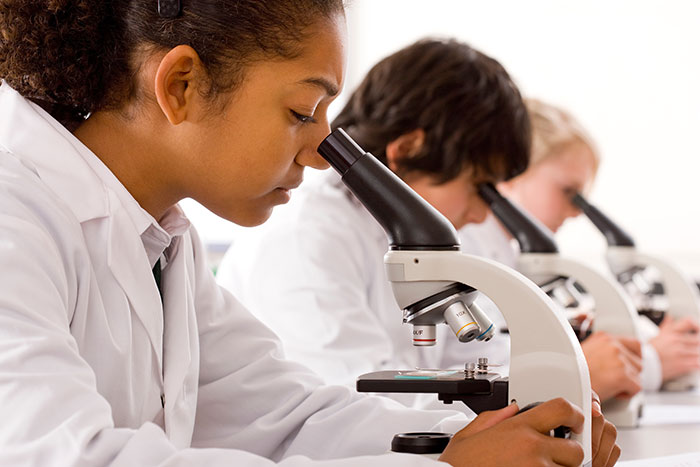CURRICULUM.

The Maine BIOLAB approach emphasizes the practices of science and engineering, building the critical thinking and problem-solving abilities that are vital for success in these fields. In addition to learning new skills in a hands-on environment, participants will gain a holistic understanding of the bioscience industry and opportunities available to them.
The best part? All Maine BIOLAB lessons are turnkey and free for teachers, promoting inclusivity and accessibility. Climb aboard and join us in shaping the future of science education!
It’s All In Your Head
Students explore how concussions occur. Using force data, students will design a helmet that could better protect the brain from injury.
Next Generation Science Standards Connections:
MS-PS2-1 Apply Newton’s Third Law to design a solution to a problem involving the motion of two colliding objects.
HS-PS2-3 Apply scientific and engineering ideas to design, evaluate, and refine a device that minimizes the force on a macroscopic object during a collision.
Activity Materials for Teachers:
Looking Into Lactose
Students explore enzyme specificity and enzyme activity through an investigation into lactose intolerance and its symptoms.
Next Generation Science Standards Connections:
5-PS1-4 Conduct an investigation to determine whether the mixing of two or more substances results in new substances.
MS-PS1-2 Analyze and interpret data on the properties of substances before and after the substances interact to determine if a chemical reaction has occurred.
HS-LS1-7 Use a model to illustrate that cellular respiration is a chemical process whereby the bonds of food molecules and oxygen molecules are broken and the bonds in new compounds are formed, resulting in a net transfer of energy.
Activity Materials for Teachers:
Maintaining Balance
The students will be presented with the following problem: “Our ecosystem’s population balance has gone out of control. We need to fix our ecosystem to make sure there is equilibrium amongst the species.” The students will put on their engineering hats to assist in maintaining species populations within an ecosystem. The teams will have an opportunity to design a tool to remove the invasive species and restore balance to the ecosystem.
Next Generation Science Standards Connections:
MS-LS2-4 Construct an argument supported by empirical evidence that changes to physical or biological components of an ecosystem affect populations.
HS-LS2-7 Design, evaluate, and refine a solution for reducing the impacts of human activities on the environment and biodiversity.
Activity Materials for Teachers:
Parasite Predicament
Students explore the antigen-antibody relationship and complete an enzyme- linked immunosorbent assay (ELISA) to determine if a patient has contracted the malaria parasite.
Next Generation Science Standards Connections:
HS-LS1-1 Construct an explanation based on evidence for how the structure of DNA determines the structure of proteins which carry out the essential functions of life through systems of specialized cells.
Activity Materials for Teachers:
Water Quality
Students explore a number of parameters including temperature, dissolved oxygens, nitrates, phosphates, and more to determine which are most important in determining whether water is safe.
Next Generation Science Standards Connections:
MS-LS2-4 Construct an argument supported by empirical evidence that changes to physical or biological components of an ecosystem affect populations.
Activity Materials for Teachers:
What’s In a Change?
In this experiment, students are introduced to chemical and physical changes and challenged to use data and observations to determine types of changes. Students will observe physical and chemical properties of reactants and products to determine if a new product with different properties is created.
Next Generation Science Standards Connections:
5-PS1-1 Develop a model to describe that matter is made of particles too small to be seen.
MS-PS1-2 Analyze and interpret data on the properties of substances before and after the substances interact to determine if a chemical reaction has occurred.
Activity Materials for Teachers:
Where Did the Sugar Go?
This lesson focuses on how sugar moves throughout the body and the effect diabetes can have on these processes. This activity includes 3 student stations: meal prepping, monitoring, and motion. At the meal prepping station, students are challenged to plan a meal that fits the carbohydrate constraints of a diabetic patient. At the monitoring station, students use a glucometer to test simulated patient blood samples taken before and after eating a meal. At the motion station, students use glucose test strips to test simulated patient plasma samples taken before and after exercising.
Next Generation Science Standards Connections:
MS-LS1-3 Use argument supported by evidence for how the body is a system of interacting sub-systems composed of groups of cells.
Activity Materials for Teachers:
Micropipette Challenge
Students review the metric system while also practicing micropipette skills as they move dyed samples to create the visual spectrum.
Next Generation Science Standards Connections:
Coming soon!
Activity Materials for Teachers:
Genomics
Coming soon!
Next Generation Science Standards Connections:
Coming soon!
Activity Materials for Teachers:
Coming Soon!
Curriculum adapted with permission from Learning Undefeated, all rights reserved.
